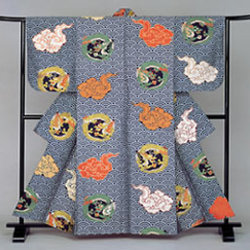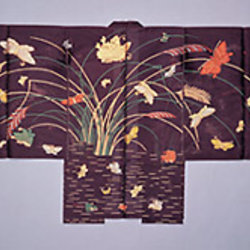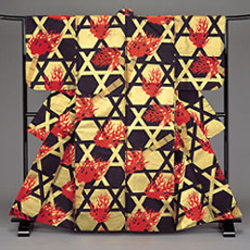Nô-Theater
The exhibition "Noh theatre" at the Austrian Theatre Museum offers visitors insights into the fascinating world of traditional Japanese theatre. The most important exhibits are magnificent costumes from the collections of the Yamaguchi Noh Costume Research Center (Kyoto) that are rarely shown outside Japan.
The oldest kimonos in the collection date from the late Edo period (1603-1868), and will be displayed together with modern replicas copied from old designs by the silk-weaving workshop of master Akhira Yamaguchi. Countless steps are necessary to obtain the required quality of silk and weaving. The costumes´ unique magnificence and beauty are cleverly contrasted with the bareness of the stage: a backdrop made of polished cypress-wood sets off the colourful silk costumes to best advantage.
Both the robes´ colours and designs carry symbolic meanings and tell us a lot about the character of each role: the colour red, for example, symbolises good fortune, beauty and youth and is thus mainly used for roles of young beautiful women.
Noh theatre was invented in the 14th century by Kan´ami (1333-1384) and his even more important son, Zeami (1363-1444). Unlike popular Kabuki theatre, Noh theatre was a courtly art. Even today, the fact that the finest materials available are used for stage-sets, costumes and props still documents the courtly, elitist character of Noh theatre. The plot is usually taken from ancient Japanese or Chinese legends and reflects the influence of Zen Buddhism.
The plot focuses on man´s encounter with creatures from the spiritual and invisible world. Demons and monsters, gods and spirits intervene in man´s life and subject him to a series of trials.
Until today, Noh theatre is performed only by male actors. Ideally, the art of Noh is handed down through the generations, from father to son. Every gesture, every action is highly formalised. Even dressing an actor is strictly reglemented, the rules reminiscent of court ceremonials.
Also on show in the exhibition are masks, musical instruments, wigs and ink drawings (loans from the Ethnological Museum, and the Museum of Applied Arts in Vienna). Photographs and videos will document contemporary Noh performances. A varied programme of events will accompany the exhibiton.





